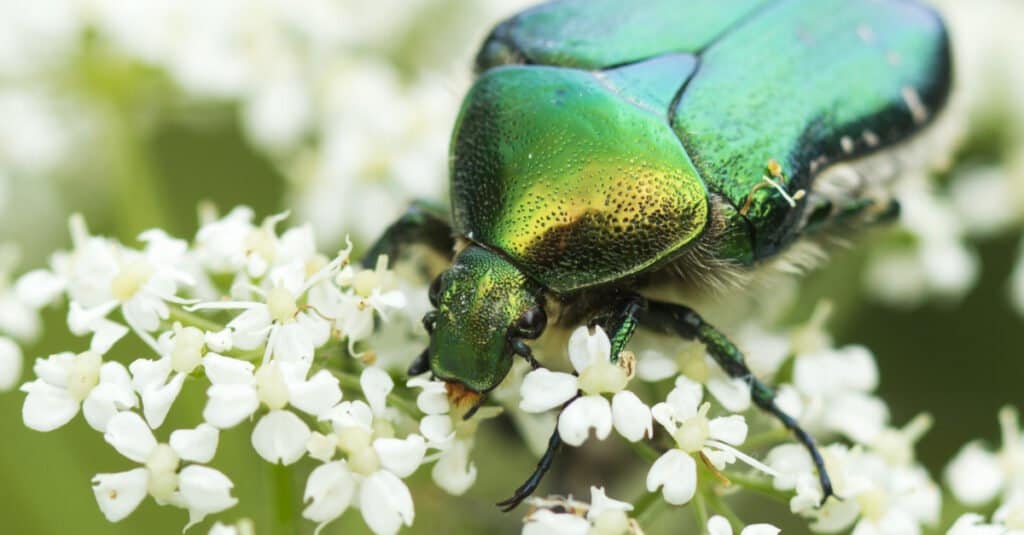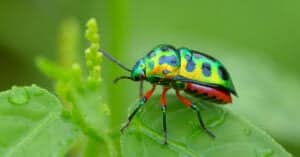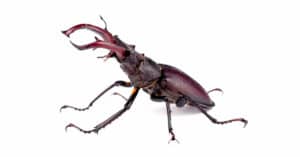When looking at the Green June Beetle (Cotinis nitida), it’s easy to see why many people refer to the little bug as a beautiful menace. The striking emerald-green color that spreads across the beetle’s shell is a thing of beauty. However, throughout its lifetime, a Green June Beetle can cause destructive damage to vital fruits and crops throughout an area.
The following guide will provide a closer look at these incredible little beetles and the impact they can have on their environment.
Where Does the Green June Beetle Live?
The Green June Beetle is a popular beetle species found throughout the eastern region of North America. While often found as far up as the southern part of Canada, they are most common in the southeastern communities of the United States.
Regardless of continent, these beetles prefer to live in areas with plenty of vegetation where they can fly from food source to food source. When it comes time to lay their eggs, females will burrow into the soil during winter. However, the newborn larvae won’t leave the comfort of the soil until they move into the adult stage of their life cycle.
It’s common to see adult Green Beetles during the daytime as they prefer to look for food while the sun is high in the sky. Although, it’s possible to see these insects flying around light sources such as porch lights and street lamps at night.
What Does the Green June Beetle Eat?
The diet of the Green June Beetle depends on the stage of life it’s in. For example, while the insect is primarily an herbivore, during the larvae stage, it will feed on the roots of plants. In addition, several of the larvae’s food sources include items such as various types of grasses and agricultural crops.
Since the larvae tend to feed on important plants and vegetables, many humans see the young beetles as pests. However, the adult Green June Beetles play a vital role in the ecosystem as a pollinator for flowers and plants.
Along with a diet of flower nectar, adult beetles also spend their time searching for fruits, including apples, grapes, strawberries, plums, and peaches. So even though the Green June Beetle doesn’t threaten humans, its presence allows other insects and pathogens to move into the crops it feasts on.

A Green June beetle eating flowers. These types of beetles are turf pests that eat a variety of vegetation.
©Galina Savina/Shutterstock.com
How Big Do Green June Beetles Grow?
Green June Beetles are classified as larger, more robust beetles. With an average length of 1.25 inches and an average width of .75 inches, the insect is much bigger than other beetle species.
While both males and females tend to be around the same size, there is a distinct difference in the shape of their bodies and antennas. The male Green June Beetle is generally longer, with a slightly larger body and flattened antennae. On the other hand, females tend to be shorter than their male counterparts and feature pointed antennae.
Throughout the larvae stage, young beetles can grow larger than their parents and often have an average length of 1.5 inches with a distinguishing C-shaped body.
The Green June Beetle Life Cycle
Like other species of insects and beetles, the Green June Beetle goes through different stages of its life cycle — egg, larvae, and adult. The entire life cycle generally lasts for a year, with most of the time spent in the larvae stage. Below is a closer look at each phase of the metamorphosis process.
Egg Stage
The first stage of the Green Beetle occurs during late spring or early summer when the female burrows into the soil to lay her eggs. These white and oval-shaped eggs typically take around two weeks to hatch. Once hatched, the beetle moves into the next stage of life — the larva stage.
Larva Stage
Green June Beetles spend most of their lives within the larva stage and are called “white grubs.” During this phase of life, the white grubs will spend their time feeding on the roots of various plants and grasses. Over several months, they’ll undergo several changes, molting and growing larger.
Towards the end of the larva stage, the white grubs will pupate in the soil, encasing themselves in a protective cocoon before entering the adult stage of life.

The larvae of the June bugs live underground, feeding on plant roots.
©theapflueger/Shutterstock.com
Adult Stage
Once pupation has been completed, the white grubs will emerge from the soil as fully grown Green June Beetles. As adults, the beetle will spend several months searching for fruit and pollinating plants in the area. Towards the end of the adult stage, the Green Beetle will mate and complete its entire life cycle.
The photo featured at the top of this post is © Sudhakar Bisen/Shutterstock.com
Thank you for reading! Have some feedback for us? Contact the AZ Animals editorial team.







